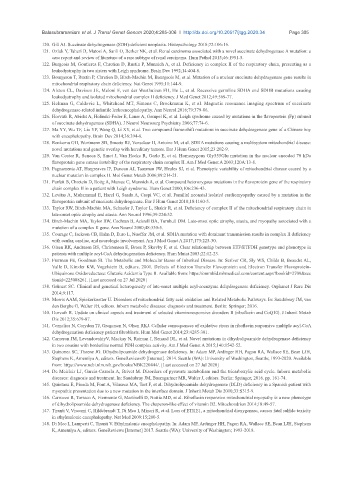Page 154 - Read Online
P. 154
Balasubramaniam et al. J Transl Genet Genom 2020;4:285-306 I http://dx.doi.org/10.20517/jtgg.2020.34 Page 305
120. Gill AJ. Succinate dehydrogenase (SDH)-deficient neoplasia. Histopathology 2018;72:106-16.
121. Ozluk Y, Taheri D, Matosi A, Sanli O, Berker NK, et al. Renal carcinoma associated with a novel succinate dehydrogenase A mutation: a
case report and review of literature of a rare subtype of renal carcinoma. Hum Pathol 2015;46:1951-5.
122. Burgeois M, Goutieres F, Chretien D, Rustin P, Munnich A, et al. Deficiency in complex II of the respiratory chain, presenting as a
leukodystrophy in two sisters with Leigh syndrome. Brain Dev 1992;14:404-8.
123. Bourgeron T, Rustin P, Chretien D, Birch-Machin M, Bourgeois M, et al. Mutation of a nuclear succinate dehydrogenase gene results in
mitochondrial respiratory chain deficiency. Nat Genet 1995;11:144-9.
124. Alston CL, Davison JE, Meloni F, van der Westhuizen FH, He L, et al. Recessive germline SDHA and SDHB mutations causing
leukodystrophy and isolated mitochondrial complex II deficiency. J Med Genet 2012;49:569-77.
125. Helman G, Caldovic L, Whitehead MT, Simons C, Brockmann K, et al. Magnetic resonance imaging spectrum of succinate
dehydrogenase-related infantile leukoencephalopathy. Ann Neurol 2016;79:379-86.
126. Horvath R, Abicht A, Holinski-Feder E, Laner A, Gempel K, et al. Leigh syndrome caused by mutations in the flavoprotein (Fp) subunit
of succinate dehydrogenase (SDHA). J Neurol Neurosurg Psychiatry 2006;77:74-6.
127. Ma YY, Wu TF, Liu YP, Wang Q, Li XY, et al. Two compound frame-shift mutations in succinate dehydrogenase gene of a Chinese boy
with encephalopathy. Brain Dev 2014;36:394-8.
128. Renkema GH, Wortmann SB, Smeets RJ, Venselaar H, Antoine M, et al. SDHA mutations causing a multisystem mitochondrial disease:
novel mutations and genetic overlap with hereditary tumors. Eur J Hum Genet 2015;23:202-9.
129. Van Coster R, Seneca S, Smet J, Van Hecke R, Gerlo E, et al. Homozygous Gly555Glu mutation in the nuclear encoded 70 kDa
flavoprotein gene causes instability of the respiratory chain complex II. Am J Med Genet A 2003;120A:13-8.
130. Pagnamenta AT, Hargreaves IP, Duncan AJ, Taanman JW, Heales SJ, et al. Phenotypic variability of mitochondrial disease caused by a
nuclear mutation in complex II. Mol Genet Metab 2006;89:214-21.
131. Parfait B, Chretein D, Rotig A, Marsac C, Munnich A, et al. Compound heterozygous mutations in the flavoprotein gene of the respiratory
chain complex II in a patient with Leigh syndrome. Hum Genet 2000;106:236-43.
132. Levitas A, Muhammad E, Harel G, Saada A, Caspi VC, et al. Familial neonatal isolated cardiomyopathy caused by a mutation in the
flavoprotein subunit of succinate dehydrogenase. Eur J Hum Genet 2010;18:1160-5.
133. Taylor RW, Birch-Machin MA, Schaefer J, Taylor L, Shakir R, et al. Deficiency of complex II of the mitochondrial respiratory chain in
late-onset optic atrophy and ataxia. Ann Neurol 1996;39:224-32.
134. Birch-Machin MA, Taylor RW, Cochran B, Ackrell BA, Turnbull DM. Late-onset optic atrophy, ataxia, and myopathy associated with a
mutation of a complex II gene. Ann Neurol 2000;48:330-5.
135. Courage C, Jackson CB, Hahn D, Euro L, Nuoffer JM, et al. SDHA mutation with dominant transmission results in complex II deficiency
with ocular, cardiac, and neurologic involvement. Am J Med Genet A 2017;173:225-30.
136. Olsen RK, Andresen BS, Christensen E, Bross P, Skovby F, et al. Clear relationship between ETF/ETFDH genotype and phenotype in
patients with multiple acyl-CoA dehydrogenation deficiency. Hum Mutat 2003;22:12-23.
137. Frerman FE, Goodman SI. The Metabolic and Molecular Bases of Inherited Disease. In: Scriver CR, Sly WS, Childs B, Beaudet AL,
Valle D, Kinzler KW, Vogelstein B, editors. 2001. Defects of Electron Transfer Flavoprotein and Electron Transfer Flavoprotein-
Ubiquinone Oxidoreductase: Glutaric Acidemia Type II. Available from: https://ommbid.mhmedical.com/content.aspx?bookid=2709&sec
tionid=225088261. [Last accessed on 27 Jul 2020]
138. Grünert SC. Clinical and genetical heterogeneity of late-onset multiple acyl-coenzyme dehydrogenase deficiency. Orphanet J Rare Dis
2014;9:117.
139. Morris AAM, Spiekerkoetter U. Disorders of mitochondrial fatty acid oxidation and Related Metabolic Pathways. In: Saudubray JM, van
den Berghe G, Walter JH, editors. Inborn metabolic diseases: diagnosis and treatment. Berlin: Springer; 2016.
140. Horvath R. Update on clinical aspects and treatment of selected vitamin-responsive disorders II (riboflavin and CoQ10). J Inherit Metab
Dis 2012;35:679-87.
141. Cornelius N, Corydon TJ, Gregersen N, Olsen RKJ. Cellular consequences of oxidative stress in riboflavin responsive multiple acyl-CoA
dehydrogenation deficiency patient fibroblasts. Hum Mol Genet 2014;23:4285-301.
142. Cameron JM, LevandovskiyV, Mackay N, Raiman J, Renaud DL, et al. Novel mutations in dihydrolipoamide dehydrogenase deficiency
in two cousins with borderline normal PDH complex activity. Am J Med Genet A 2015;140:1542-52.
143. Quinonez SC, Thoene JG. Dihydrolipoamide dehydrogenase deficiency. In: Adam MP, Ardinger HH, Pagon RA, Wallace SE, Bean LJH,
Stephens K, Amemiya A, editors. GeneReviews® [Internet]. 2014. Seattle (WA): University of Washington, Seattle; 1993-2020. Available
from: https://www.ncbi.nlm.nih.gov/books/NBK220444/. [Last accessed on 27 Jul 2020]
144. De Meirleir LJ, Garcia-Cazorla A, Brivet M. Disorders of pyruvate metabolism and the tricarboxylic acid cycle. Inborn metabolic
diseases: diagnosis and treatment. In: Saudubray JM, Baumgartner MR, Walter J, editors. Berlin: Springer; 2016. pp. 161-74.
145. Quintana E, Pineda M, Font A, Vilaseca MA, Tort F, et al. Dihydrolipoamide dehydrogenase (DLD) deficiency in a Spanish patient with
myopathic presentation due to a new mutation in the interface domain. J Inherit Metab Dis 2010;33:S315-9.
146. Carrozzo R, Torraco A, Fiermonte G, Martinelli D, Nottia MD, et al. Riboflavin responsive mitochondrial myopathy is a new phenotype
of dihydrolipoamide dehydrogenase deficiency. The chaperon-like effect of vitamin B2. Mitochondrion 2014;18:49-57.
147. Tiranti V, Viscomi C, Hildebrandt T, Di Meo I, Mineri R, et al. Loss of ETHE1, a mitochondrial dioxygenase, causes fatal sulfide toxicity
in ethylmalonic encephalopathy. Nat Med 2009:15;200-5.
148. Di Meo I, Lamperti C, Tiranti V. Ethylmalonic encephalopathy. In: Adam MP, Ardinger HH, Pagon RA, Wallace SE, Bean LJH, Stephens
K, Amemiya A, editors. GeneReviews [Internet] 2017. Seattle (WA): University of Washington; 1993-2018.

